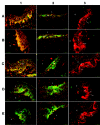Immunolocalization and expression of vascular endothelial growth factor receptors (VEGFRs) and neuropilins (NRPs) on keratinocytes in human epidermis
- PMID: 17088944
- PMCID: PMC1626599
- DOI: 10.2119/2006-00024.Man
Immunolocalization and expression of vascular endothelial growth factor receptors (VEGFRs) and neuropilins (NRPs) on keratinocytes in human epidermis
Abstract
Vascular endothelial growth factor (VEGF) plays an important role in normal and pathological angiogenesis. VEGF receptors (VEGFRs, including VEGFR-1, VEGFR-2, and VEGFR-3) and neuropilins (NRPs, including NRP-1 and NRP-2) are high-affinity receptors for VEGF and are typically considered to be specific for endothelial cells. Here we showed expression of VEGFRs and NRPs on cultured epidermal keratinocytes at both mRNA and protein levels. We further localized these receptors by immunofluorescence (IF) staining in the epidermis of surgical skin specimens. We found positive staining for VEGFRs and NRPs in all layers of the epidermis except for the stratum corneum. VEGFR-1 and VEGFR-2 are primarily expressed on the cytoplasmic membrane of basal cells and the adjacent spinosum keratinocytes. All layers of the epidermis except for the horny cell layer demonstrated a uniform pattern of VEGFR-3, NRP-1, and NRP-2. Sections staining for NRP-1 and NRP-2 also showed diffuse intense fluorescence and were localized to the cell membrane and cytoplasm of keratinocytes. In another panel of experiments, keratinocytes were treated with different concentrations of VEGF, with or without VEGFR-2 neutralizing antibody in culture. VEGF enhanced the proliferation and migration of keratinocytes, and these effects were partially inhibited by pretreatment with VEGFR-2 neutralizing antibody. Adhesion of keratinocytes to type IV collagen-coated culture plates was decreased by VEGF treatment, but this reduction could be completely reversed by pretreatment with VEGFR-2 neutralizing antibody. Taken together, our results suggest that the expression of VEGFRs and NRPs on keratinocytes may constitute important regulators for its activity and may possibly be responsible for the autocrine signaling in the epidermis.
Figures






Similar articles
-
[Advances of research on vascular endothelial growth factor receptors in epidermal neoplasm].Zhejiang Da Xue Xue Bao Yi Xue Ban. 2009 Jul;38(4):422-6. Zhejiang Da Xue Xue Bao Yi Xue Ban. 2009. PMID: 19693983 Review. Chinese.
-
Expression and regulation of neuropilins and VEGF receptors by TNF-alpha in human endothelial cells.J Surg Res. 2004 Dec;122(2):249-55. doi: 10.1016/j.jss.2004.05.007. J Surg Res. 2004. PMID: 15555625
-
Inhibitory activity of ranibizumab, sorafenib, and pazopanib on light-induced overexpression of platelet-derived growth factor and vascular endothelial growth factor A and the vascular endothelial growth factor A receptors 1 and 2 and neuropilin 1 and 2.Retina. 2012 Sep;32(8):1652-63. doi: 10.1097/IAE.0b013e318240a558. Retina. 2012. PMID: 22466477
-
Role of VEGF receptors in normal and psoriatic human keratinocytes: evidence from irradiation with different UV sources.PLoS One. 2013;8(1):e55463. doi: 10.1371/journal.pone.0055463. Epub 2013 Jan 31. PLoS One. 2013. PMID: 23383198 Free PMC article.
-
VEGF-A121a binding to Neuropilins - A concept revisited.Cell Adh Migr. 2018 May 4;12(3):204-214. doi: 10.1080/19336918.2017.1372878. Epub 2017 Nov 2. Cell Adh Migr. 2018. PMID: 29095088 Free PMC article. Review.
Cited by
-
NRP-1 Receptor Expression Mismatch in Skin of Subjects with Experimental and Diabetic Small Fiber Neuropathy.PLoS One. 2016 Sep 6;11(9):e0161441. doi: 10.1371/journal.pone.0161441. eCollection 2016. PLoS One. 2016. PMID: 27598321 Free PMC article.
-
NRP-1 interacts with GIPC1 and α6/β4-integrins to increase YAP1/∆Np63α-dependent epidermal cancer stem cell survival.Oncogene. 2018 Aug;37(34):4711-4722. doi: 10.1038/s41388-018-0290-4. Epub 2018 May 14. Oncogene. 2018. PMID: 29755126 Free PMC article.
-
Cutaneous lupus erythematosus after treatment with paclitaxel and bevacizumab for metastatic breast cancer: a case report.J Med Case Rep. 2011 Jun 27;5:243. doi: 10.1186/1752-1947-5-243. J Med Case Rep. 2011. PMID: 21707979 Free PMC article.
-
Epidermal expression of neuropilin 1 protects murine keratinocytes from UVB-induced apoptosis.PLoS One. 2012;7(12):e50944. doi: 10.1371/journal.pone.0050944. Epub 2012 Dec 10. PLoS One. 2012. PMID: 23251405 Free PMC article.
-
VEGF upregulates VEGF receptor-2 on human outer root sheath cells and stimulates proliferation through ERK pathway.Mol Biol Rep. 2012 Sep;39(9):8687-94. doi: 10.1007/s11033-012-1725-6. Epub 2012 Jun 16. Mol Biol Rep. 2012. PMID: 22707147
References
-
- Ferrara N. Vascular endothelial growth factor: basic science and clinical progress. Endocr Rev. 2004;25:581–611. - PubMed
-
- Carmeliet P, Tessier-Lavigne M. Common mechanisms of nerve and blood vessel wiring. Nature. 2005;436:193–200. - PubMed
-
- Stacker SA, Achen MA. The vascular endothelial growth factor family: signalling for vascular development. Growth Factors. 1999;17:1–11. - PubMed
-
- Veikkola T, Alitalo K. VEGFs, receptors and angiogenesis. Semin Cancer Biol. 1999;9:211–20. - PubMed
-
- Neufeld G, Cohen T, Gengrinovitch S, Poltorak Z. Vascular endothelial growth factor (VEGF) and its receptors. FASEB J. 1999;13:9–22. - PubMed
Publication types
MeSH terms
Substances
LinkOut - more resources
Full Text Sources
Other Literature Sources
Miscellaneous
